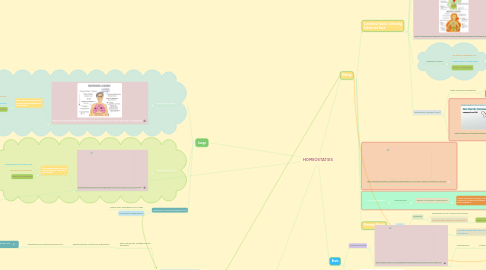
1. return to Homeostasis
2. Lungs
2.1. Respiratory Acidosis
2.1.1. https://nurseslabs.com/wp-content/uploads/2013/05/Respiratory-Acidosis-Signs-and-Symptoms.jpg
2.1.1.1. Later stages lungs unable to correct, kidneys attempt to compensate
2.1.1.1.1. Excretion of hydrogen ions
2.1.1.1.2. Reabsorption of bicarbonate
2.1.1.1.3. return to Homeostasis
2.2. Respiratory Alkalosis
2.2.1. http://www.medicalzone.net/uploads/1/2/7/3/12737542/140194_orig.jpg
2.2.1.1. Later stages lungs unable to correct, kidneys attempt to compensate
2.2.1.1.1. Reabsorption of hydrogen ions
2.2.1.1.2. Excretion of bicarbonate
2.2.1.1.3. return to Homeostasis
2.3. Angiotensin Converting Enzyme (ACE)
2.3.1. Produced by endothelial cells of lungs
2.3.2. Produced to support RAAS
3. Heart
3.1. Low Blood-Pressure
3.1.1. Affects kidneys
3.1.1.1. Activation of Renin Angiotensin Aldosterone System (RAAS)
3.1.1.1.1. Renin released by Juxtraglomerular Apparatus
3.1.1.1.2. Fluid regulation cycle, including antidiuretic hormone (ADH) and the renin-angiotensin-aldosterone (RAA) system. | SYSTÈME ENDOCRINIEN | Pinterest | Fluid and electrolytes, Physiology and Medical
3.2. Poor contractility
3.2.1. Low calcium
3.2.1.1. Activation of Parathyroid Home (PTH) from parathyroid gland
3.2.1.1.1. Affects kidneys
4. Kidney
4.1. Late Distal Tubule, Collecting Tubule and Duct
4.1.1. Aldosterone: Present
4.1.1.1. activation of RAAS
4.1.1.1.1. Sodium is reabsorbed and potassium is secreted
4.1.1.2. Produced by Adrenal Gland
4.1.2. Parathyroid Hormone: Present
4.1.2.1. calcium is reabsorbed
4.1.2.1.1. heart contractility improves, strong heart beats; better blood-pressure
4.1.3. Metabolic Alkalosis
4.1.3.1. Reabsorption of hydrogen ions
4.1.3.2. Excretion of bicarbonate
4.1.3.3. return to Homeostasis
4.1.4. https://i.pinimg.com/originals/11/94/95/1194953e4890a3e984d092cb216b9bd2.jpg
4.1.5. Metabolic Acidosis
4.1.5.1. Excretion of hydrogen ions
4.1.5.2. Reabsorption of bicarbonate
4.1.5.3. return to Homeostasis
4.1.6. Anti-Diuretic Hormone (ADH)
4.1.6.1. Water reabsorbed interstitium
4.1.6.1.1. Results in concentrated urine
4.1.6.1.2. increases circulating fluid increasing blood volume and stabilizing blood-pressure
4.1.6.2. https://study.com/cimages/multimages/16/vasopressin.jpg
4.2. http://heritance.me/wp-content/uploads/anatomy-of-kidney-nephron-britannica-com.jpg
4.3. Low Blood-Pressure
4.3.1. Adrenal Gland
4.3.1.1. Results in activation of Aldosterone
4.3.1.1.1. causes retention of sodium to pull fluid volume to increase and stabilize blood-pressure
4.4. Proximal Tubule
4.4.1. Sodium
4.4.1.1. Potassium
4.4.1.1.1. Reabsorbed via co-transport with sodium
4.4.1.1.2. Excreted with activation of Aldosterone
4.4.1.2. Reabsorbed in the proximal tubule
4.4.1.2.1. Increased reabsorption with activation of aldosterone
5. Brain
5.1. Low blood volume
5.1.1. http://www.austincc.edu/apreview/NursingPics/VascularPics/Picture30.jpg
5.1.1.1. Hypothalamus
5.1.1.1.1. Posterior Pituitary Gland

